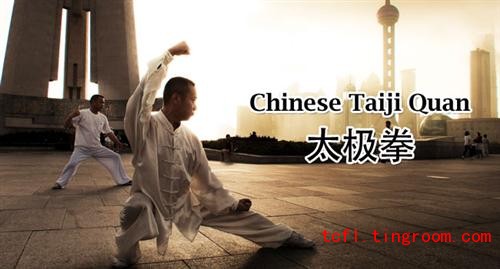Overview
Millions of people practice Taiji Quan every day, and it is fast becoming one of the most popular exercise systems in the world. Originating in China, Taijiquan is famed for its health benefits and revered for its philosophical, cultural, and historical traditions. Disciplines similar to Taiji Quan have been practiced in China for over 2,000 years, but from the 18th century onward a series of fixed postures and movements, which connect and flow into one another, evolved into Taiji Quan. These set patterns of “moving meditation” are known as forms, and there are now five main and very separate styles in existence, each of differing length and method.
Anyone can do Taiji Quan; there are no physical or mental barriers to knowledge the form, and the best way to perform is methodically and slowly, absorbing each movement accurately, and doing at least a little every day to build up slowly on the sequences. Although, the form can be learned alone, it is useful to work with a partner on occasion, so that progress, precision and stability of posture can be monitored. Speed is not a consideration when learning Taijiquan. It is far more important that the form be trained at a pace that is comfortable, with the emphasis on accuracy of position rather than speed.
Learning the moves and stances of the form is just the beginning of understanding the energies and dynamics of Taiji Quan; once the basics have been absorbed, advanced skills such as pushing hands and applications can be developed. These are exercises involving sustained partner work, designed to build up acute awareness of an opponent’s actions and the ability to anticipate their intentions.
Even if nowadays often accomplished as a spiritual and physical fitness regimen, Taijiquan was fundamentally a fighting system, and like any other martial art, it has its competitive side. Practitioners attend tournaments of pushing hands drills, and set displays of weaponry skills –called forms- are performed using ceremonial swords and other traditional weapons.
Why Practice Taiji Quan?
The phrase Taiji Quan translates from Chinese as “great polarity boxing”, drawing on the traditional Chinese Taoist beliefs in the interdependence of yin and yang in the body and mind. These are apparently opposing forces that in fact complement each other and can be complete only when balanced in harmony.
Skilled Taiji Quan exponents exploit the strength of the earth (yin) and the energy (ji) of the heavens (yang)to focus their physical and spiritual energies so that mind and body work together to improve balance, stability, flexibility, and skill.
As an integrated exercise system for both mind and body, Taijiquan is an enjoyable and effective way to reduce stress and avoid mental and physical tension, while at the same time helping to cultivate inner spiritual strength and creativity.
The Origin of Taiji Quan
Though the true origins of Taiji Quan have been lost in time and many legends have grown around its development, what is known is that China has always had a strong martial tradition. This dates back to the feudal rivalry of the Warring States period (402-221 BC). China was divided into city-states, which were defended by bands of aristocratic warriors, some of whom were influenced by the teachings of Confucius (551-479 BC). They took part in ritual archery tournaments, testing self-control, poise, and resilience, skills still important in Taijiquan today.
Closely linked to the history of Taijiquan is Bodhidharma, the 6th century wandering monk and founder of Zen Buddhism. He came to China from southern India, and legend claims that he taught yoga-based exercises to the monks of the Shaolin temple at Henan. This system helped to strengthen their minds and bodies for meditation, and it may have been a precursor to Taijiquan in its present form, since the regime encouraged the mind and body to work together to be more efficient. Shaolin temple boxing may also have developed from Bodhidharma’s exercise system.
Zhang Sanfeng
The 13th century Taoist sage Zhang Sanfeng is also closely connected with the mythology of Taijiquan. According to legend, he learned his martial arts at the Henan Shaolin temple and went on to train at the famous Taoist retreat at Wu-Tang. There, as a result of a dream encounter with a warrior god, he developed a new, “soft”, “internal” approach to martial arts, using the energies generated from within that are central to the practice of Taijiquan today. This was influenced by the work of Lao Tzu, the 6th century BC founder of Taoism, which teaches that the secret of life is to live in accordance with the Tao (“way”), “which does nothing, yet leaves nothing undone”.
The first evidence of a familiar style of Taijiquan dates from the 18th century, with the Ch’en family of Henan province. The origins of the Ch’en family exercise scheme are obscure –a wandering boxer may have taught his fighting system to the Ch’en family, or it may have been developed by one of the family in the 17th century. It is impossible to say what this early Taijiquan looked like. It may have been a series of simple workouts, with an emphasis placed on individual set positions rather than on the connecting movements.
In the 19th century the Ch’en family’s exercise technique was acquired by Yang Lu-quan, a family servant. How Yang gained his knowledge of this method is not certain, but what is clear is that much of the recent development of Taijiquan can be attributed to him, since he established the Yang style, which is famous today.
Other styles of Taiji Quan have emerged over the years, including the Wu style, a revised Ch’en style, a composite style developed by Sun Lu-Tang, and the shortened version of the Yang form, developed in the 1940s by Professor Cheng Man-Ch’ing.
 English
English Japanese
Japanese Korean
Korean French
French German
German Spanish
Spanish Italian
Italian Arab
Arab Portuguese
Portuguese Vietnamese
Vietnamese Russian
Russian Finnish
Finnish Thai
Thai dk
dk